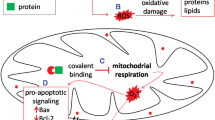Abstract
In the course of biotransformation reactions catalyzed both by cytochrome P450 and by conjugating enzymes, drug-derived reactive metabolites and active oxygen species can appear that may escape the detoxification process, initiating radical chain reactions (e.g., lipid peroxidation), covalently binding to macromolecules (proteins, DNA), or impairing the energetic balance of cells. This is usually followed by alterations of ion homeostasis that precede irreversible biochemical changes and cell death. There are, however, cellular mechanisms of defense that prevent, or repair, the damage caused by these reactive intermediates. Ultimately it is the balance between bioactivation, detoxification, and defense mechanisms that determines whether a compound will or will not elicit a toxic effect. Cultures of hepatocytes, including those of human origin, can be used to elucidate the mechanisms of drug toxicity. This is illustrated in the study of the mechanism of hepatotoxicity by diclofenac. Much less cytotoxicity is observed in nonmetabolizing hepatomas than in hepatocytes. The observed cell dysfunction parallels the biotransformation of the drug, and particularly the formation of the minor metabolite N,5-dihydroxydiclofenac by hepatocytes. This compound is able to inhibit mitochondrial ATP synthesis in hepatocytes.
Similar content being viewed by others
References
Boelsterli UA. Specific targets of covalent drug—protein interactions in hepatocytes and their toxicological significance in drug-induced liver injury. Drug Metab Rev. 1993;25:395–451.
Boobis AR, Duncan J, Fawthrop J, Davies DS. Mechanisms of cell death. Trends Pharm Sci. 1989;10:275–280.
Carmichael J, DeGraff WG, Gazdar AF, Minna JD, Mitchell JB. Evaluation of a tetrazolium-based semiautomated colorimetric assay: assessment of chemosensitivity testing. Cancer Res. 1987;47:936–942.
Castell JV, Gómez-Lechón MJ. In vitro investigation of the molecular mechanisms of hepatotoxicity. In: Castell JV, Gómez-Lechón MJ, eds. In vitro methods in pharmaceutical research. London: Academic Press; 1996:375–410.
Castell JV, Montoya A, Larrauri A, López P, Gómez-Lechón MJ. Effects of benorylate and impacine on the metabolism of cultured hepatocytes. Xenobiotica. 1985;15:743–749
Clapham DE. Calcium signaling. Cell. 1995;80:259–268.
Columbano A. Cell death: current difficulties in discriminating apoptosis from necrosis in the context of pathological processes in vivo. J Cell Biochem. 1995;58:181–190.
Duverger-van Bogaert M, Wiame D, Stecca C. Oxidative activation of 2-aminofluorene by human red blood cell cytosol. Biochem Pharmacol. 1992;44:2422–2424.
Eriksson UG, Brasch RC, Tozer TN. Nonenzymatic bioreduction in rat liver and kidney of nitroxyl spin labels, potential contrast agents in magnetic resonance imaging. Drug Metab Dispos. 1987;15:155–160.
Gómez-Lechón MJ, Donato T, Ponsoda X, Fabra R, Trullenque R, Castella JV. Isolation, culture and use of human hepatocytes in drug research. In: Castell JV, Gómez-Lechón MJ, eds. In vitro methods in pharmaceutical research. London: Academic Press; 1996:129–154.
Hinson JA, Roberts DW. Role of covalent and noncovalent interactions in cell toxicity: effects on proteins. Annu Rev Pharmacol Toxicol. 1992;32:471–510.
Kappus H. Overview of enzyme systems involved in bioreduction of drugs and redox cycling. Biochem Pharmacol. 1986;35:1–6.
Lindeke B. The non-and postenzymatic chemistry of N-oxygenated molecules. Drug Metab Rev. 1982;23:253–309.
Loeper J, Descatoire V, Maurice M et al. Cytochrome P450 in human hepatocyte plasma membrane: recognition by several autoantibodies. Gastroenterology. 1993;104:203–216.
Nieminen AL, Saylor AK, Tesfai SA, Herman B, Lemasters JJ. Contribution of the mitochondrial permeability transition to lethal injury after exposure of hepatocytes to t-butylhydroperoxide. Biochem J. 1995;307:99–106.
Poli G, Albano E, Dianzani MU. The role of lipid peroxidation in liver damage. Chem Phys Lipids. 1987;45:117–142.
Ponsoda X, Bort R, Jover R, Gómez-Lechón MJ, Castell JV. Molecular mechanisms of diclofenac hepatotoxicity: cell injury is associated to the metabolism of the drug and is precluded by a decrease in ATP levels. Toxicol In Vitro. 1995;9:439–444.
Reed JD. Glutathione: toxicological implications. Annu Rev Pharmacol Toxicol. 1990;30:603–631.
Robin MA, Maratrat M, Loeper J et al Cytochrome P4502B follows a vesicular route to the plasma membrane in cultured rat hepatocytes. Gastroenterology. 1995;108:1110–1123.
Rosen GM, Ranckman EJ, Hauck KW. Selective bioreduction of nitroxides by rat liver microsomes. Toxicol Lett. 1977;1: 71–74.
Ross D. Mechanistic toxicology: a radical perspective. J Pharm Pharmacol. 1989;41:505–511.
Rosser BG, Gores GJ. Liver cell necrosis: cellular mechanisms and clinical implications. Gastroenterology. 1995;108:252–575.
Scully LJ, Clarke D, Barr RJ. Diclofenac induced hepatitis: three cases with features of autoimmune chronic active hepatitis. Dig Dis Sci. 1993;38:744–751.
Shen W, Kamendulis LM, Ray SD, Corcoran GB. Acetaminophen-induced cytotoxicity in cultured mouse hepatocytes: effects of Ca2+-endonuclease, DNA repair, and glutathione depletion inhibitors on DNA fragmentation and cell death. Toxicol Appl Pharmacol. 1992;112:32–40.
Sies H. Oxidative stress: Introduction. In: Sies H, ed. Oxidative stress. Oxidants and antioxidants. London: Academic Press; 1971:xv–xxii.
Swartz MN. Mitochondrial toxicity: new adverse drug effects. N Engl J Med. 1995;333:1146–1148.
Testa B. The metabolism of drugs and other xenobiotics. In: Testa B, Caldwell J, eds. Biochemistry of redox reductions. London: Academic Press; 1995a:164–184.
Testa B. The metabolism of drugs and other xenobiotics. In: Testa B, Caldwell J, eds. Biochemistry of redox reductions. London: Academic Press; 1995b:424–426.
Yamada H, Babat T, Oguri K, Yoshimura H. Enzymatic reduction of N-hydroxyamphetamine: the role of electron transfer system containing cytochrome b5. Biochem Pharmacol. 1988;37:368–373.
Zimmerman HJ, Ishak KG. General aspects of drug-induced liver diseases. Gastroenterol Clin North Am. 1995;24:739–758.
Author information
Authors and Affiliations
Rights and permissions
About this article
Cite this article
Castell, J., Gómez-Lechón, M., Ponsoda, X. et al. The use of cultured hepatocytes to investigate the mechanisms of drug hepatotoxicity. Cell Biol Toxicol 13, 331–338 (1997). https://doi.org/10.1023/A:1007443610025
Issue Date:
DOI: https://doi.org/10.1023/A:1007443610025




